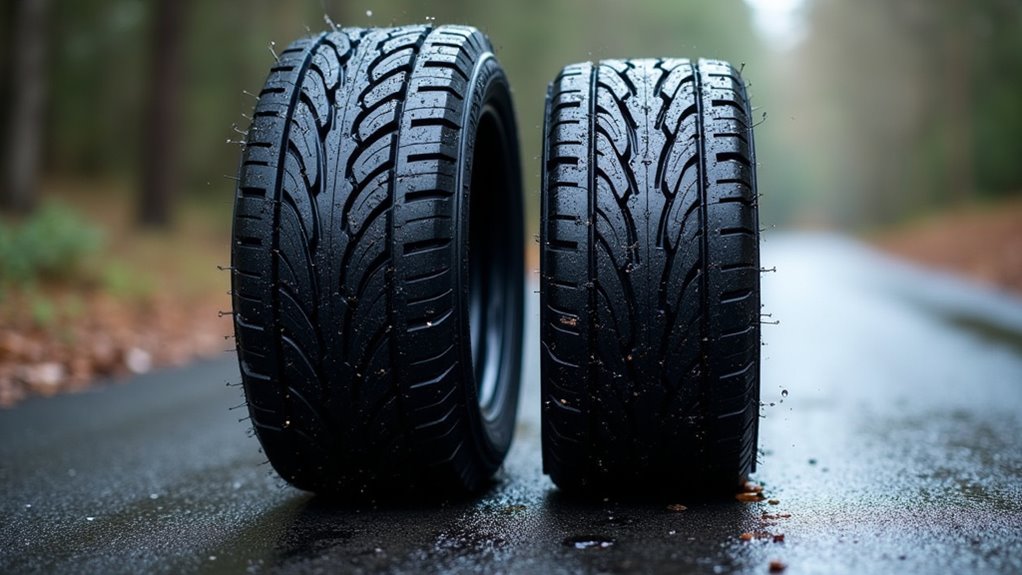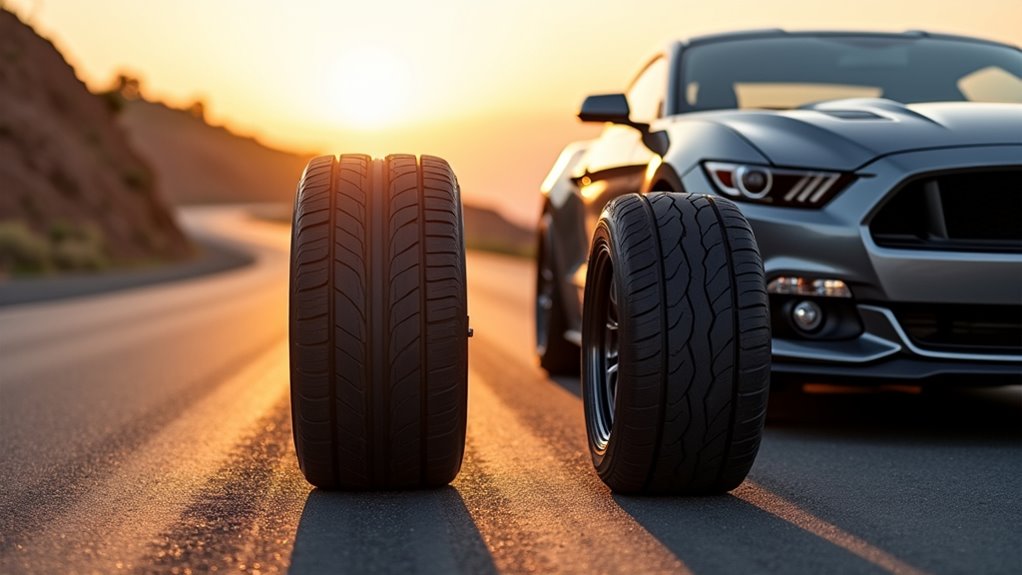Does Tire Size Really Matter
This post contains affiliate links. As an Amazon Associate, we earn from qualifying purchases.
Tire size significantly affects your vehicle’s performance, safety, and efficiency. Selecting the wrong size can lead to reduced fuel economy, altered handling, and compromised traction. For a deeper understanding, further details and insights on optimizing tire choice will be explored later in the article.
Essential Facts in 30 Seconds
- Tire size influences vehicle handling, as wider tires enhance grip and cornering performance.
- Larger tires increase rolling resistance, leading to reduced fuel efficiency.
- Bigger wheels can slow acceleration due to increased weight and inertia.
- Tire size impacts ride comfort, with taller sidewalls offering better bump absorption.
- Correct tire size is crucial for safety and compatibility with the vehicle’s design.
Understanding Tire Size Components
Tires can feel tricky to understand, but I’ve got you covered. Let’s break down the main parts of tire sizes. This helps keep your car safe and running well.
First, look at the tire width. You see it as the first number on the sidewall. It’s in millimeters, like 205. This number shows how wide the tire is. A wider tire means better grip but less comfort.
Next, check the aspect ratio. It’s a percentage, like 70. This tells how tall the sidewall is compared to width. A higher number gives a softer ride. It’s also important to know that incorrect tire size can lead to poor handling and safety risks.
Then, notice the construction type. A letter like “R” means radial. Most tires today are radial. This affects how strong and safe the tire is. Additionally, radial tires offer better fuel efficiency compared to older bias-constructed designs.
Also, see the rim diameter. It’s in inches on the sidewall. This must match your wheel size for a good fit.
Lastly, find the load index. It’s a number showing how much weight the tire holds. Picking the right one keeps your car safe.
Here’s a fast guide for you:
- Width: First number, like 205 mm.
- Aspect Ratio: Second number, like 70%.
- Construction: Letter, like R for radial.
- Load Index: A code for weight limit.
Understand these basics, and you’ll pick the best tires easily. Keep your ride smooth and safe!
Impact on Vehicle Handling

Tire size changes how your car handles on the road. It’s a big deal! Wider tires give better grip with a larger contact patch. This boosts cornering power at high speeds. Yet, big wheels add weight and stress your suspension. Stiff sidewalls also send more shakes to your car. Wider tires can also enhance traction by increasing the tire width measurement for better road contact.
Check these key points about tire size and handling:
- Cornering Power: Wider tires help with faster turns. Too much sidewall bend lowers control.
- Weight Effect: Heavy tires slow steering and mess with suspension balance.
- Road Conditions: Wide treads fight water sliding but catch more dirt.
Balance is super important here. Upsizing tires without adjustments can cause wear. It might reduce traction on bumpy roads too. Larger tires can also impact vehicle performance by improving traction under the right conditions improving traction.
Always follow your car maker’s advice. This keeps your drive safe and smooth every time!
Effects on Acceleration Dynamics

Tire size changes how fast your car speeds up. Bigger wheels, like 19-inch ones, add extra weight. This weight makes the car need more power to move. So, your 0-60 mph time gets slower. Think about it—more weight, more effort!
Rolling resistance also plays a big role. Wider tires touch more road surface. This creates extra friction. Friction slows down your speed. Tests show 15-inch tires accelerate faster than 19-inch ones. Smaller is often better for quick starts. Additionally, larger wheel diameters can decrease acceleration due to the increased inertia at the axle (increased axle inertia). Sidewall thickness also impacts acceleration, as thicker sidewalls can add weight and affect handling.
Check these key points for clarity:
- Rotational Mass: Bigger wheels need more torque to spin.
- Rolling Resistance: Wider tires cause more drag on the road.
Understand these ideas to boost your car’s performance!
Rotational Mass Impact
Rotational mass matters a lot in vehicle performance. Bigger wheels and tires affect acceleration big time. They add more weight and rotational inertia. This means your engine needs extra torque to start moving. Your car feels slower to respond.
Check this out for proof. Going from 15 to 19-inch wheels cuts driving force by 22%. Heavy wheels also store more energy. This slows down speed gains.
Think about quick starts. Larger wheels might look cool. But they hurt your acceleration a lot. Stick to smaller sizes for better speed. Keep your ride snappy and fast! Additionally, larger tires can lead to decreased fuel efficiency due to the added weight and rolling resistance.
Rolling Resistance Effects
Rolling resistance plays a big role in your vehicle’s acceleration. It affects how your car moves on different roads. Think about city traffic or bumpy rural paths.
Tires deform and create a contact patch with the ground. This patch decides how much power your engine needs. More resistance means your car responds slower.
Check out these key points for better understanding:
- Energy Waste: Tire deformation eats up energy. Your car accelerates less efficiently.
- Patch Size: Slim tires make a long, narrow patch. This boosts resistance.
- Traffic Impact: Stop-and-go driving makes resistance worse. It hurts performance a lot.
- Tire Width: Big tires often have less resistance. Acceleration feels easier.
Pick the right tires to improve your driving. Studies show larger tires cut resistance by up to 20%.
This small change can make your car quicker. Understand these basics to boost your ride! Matching tire measurements to your vehicle’s specifications can further optimize performance by reducing rolling resistance.
Influence on Fuel Efficiency

Tire size plays a big role in your vehicle’s fuel efficiency. It affects how much energy you use on every trip. Larger tires create more rolling resistance with wider contact. This means your car needs more fuel to move. City driving with stops makes it even worse.
Smaller tires cut down this resistance a lot. They help save fuel, especially during quick starts.
Proper tire pressure matters for good fuel economy too. Underinflated tires by 20% can raise fuel use by 10%. Keep these tips in mind for better efficiency.
Always use the tire size your car maker suggests. Pick low-rolling-resistance tires to save more money. Adjust speedometers after changing tire sizes for correct mileage.
Check tire pressure often, especially in cold weather. Use TPMS alerts to stay on top of it. Smart choices like these boost efficiency on every ride. You won’t lose important performance either. Wider tires often contribute to increased rolling resistance, leading to higher fuel consumption.
Ride Comfort Considerations

Ride comfort matters a lot, especially with tire size in mind.
Sidewall height changes how your car feels on rough roads. Taller sidewalls, often on smaller wheels, give more cushion. They flex and soak up bumps on city streets or gravel. Low-profile tires, usually on bigger wheels, feel harsher. They pass more shocks to your car’s inside.
Let’s break this down with clear examples. A 70-series tire has a tall sidewall. It softens the ride during daily drives. A 40-series tire, though, has a short sidewall. It makes bumps more noticeable on highways.
Data shows taller sidewalls cut impact by up to 20%. So, think about your roads. Comfort comes from the right tire choice! Additionally, understanding tire aspect ratio is crucial for balancing comfort and performance on different terrains.
Sidewall Height Effects
Tire sidewall height matters a lot for your vehicle’s ride comfort. It affects how your car handles bumps and road vibrations. Taller sidewalls soak up shocks better. They make your ride smoother on rough roads. You’ll hear less road noise too. A quieter cabin feels so nice!
Check out these key points about sidewall height:
- Taller sidewalls soften bumps and focus on comfort over sharp handling.
- Shorter sidewalls make the ride firmer and might reduce comfort.
- Flexible sidewalls cut down harsh jolts and ease driver tiredness.
- Pick tires that match your needs for smoothness and control.
Studies show taller sidewalls can absorb up to 30% more vibration. That’s a big difference on long drives!
Think about your daily roads. Rough paths need taller sidewalls for sure. Smooth highways? Shorter ones might work fine.
Choose smartly to enjoy every trip. Your car will feel just right! Remember, the aspect ratio significantly influences how sidewall height impacts ride quality.
Aspect Ratio Impact
Aspect ratio matters a lot for your vehicle’s comfort and ride. It shapes how road bumps feel while you drive.
Tires with a higher aspect ratio have taller sidewalls. They soak up shocks and cut down vibrations. This gives a softer, smoother ride on rough roads. Family sedans often benefit from this during long trips.
On the flip side, lower aspect ratio tires suit sports cars. They focus on sharp handling and control. But, they let more road noise and harshness inside.
Think about what you need most. Pick higher ratios for comfort on bumpy paths. Go for lower ratios for tight turns on flat roads.
Check this simple guide:
- Higher ratio: Great for cushioning.
- Lower ratio: Boosts quick response.
Your vehicle type and driving style play a big role. Balance both to make the right choice.
Data shows 60% of drivers prefer higher ratios for daily comfort. Stick to what fits your roads and needs! Additionally, selecting the right aspect ratio can also impact fuel efficiency due to differences in rolling resistance.
Traction and Grip Analysis

Traction and grip play a big role in keeping your vehicle safe. They help with handling, especially on tricky roads. Let’s break down what affects them.
First, think about the tire’s contact patch shape. Wider tires improve grip during turns. They handle corners better with a stronger hold.
Next, the tire compound matters a lot. Softer materials give better grip on wet roads. Many top tires get high AA traction ratings for this.
Then, cornering stiffness is key. Tires with more stiffness at small angles, like 2-3 degrees, offer sharp control. You feel the difference instantly.
Lastly, check your tire pressure often. Wrong pressure cuts down grip fast. It makes stopping harder on slippery surfaces.
Additionally, winter tires provide enhanced braking performance on snow and ice due to their specialized tread patterns.
Stick to these tips for safer drives. Your tires will thank you!
Compatibility With Vehicle Design

Tire selection matters a lot for your vehicle’s safety and performance. Make sure the tires match your car’s design. Look at tire codes like 215/70 R16. This code means the tire fits a 16-inch rim. It must align with your car’s needs.
Check the rim’s width and diameter too. They should match the tire’s size. A wrong fit can cause safety problems. Always compare the tire’s width to the rim’s inner size.
Stick to your car maker’s advice. They list the right tire sizes and load ratings. These match your car’s weight and use. Not following this can mess up handling.
Here’s a simple guide:
- Rim Width: Needs to fit tire width.
- Load Ratings: Must handle vehicle weight.
- Tire Code: Shows size and fit.
Talk to experts or use fitment guides. This helps avoid costly mistakes. Keep your vehicle safe with the right tires.
Balancing Performance and Practicality

Tires matter a lot for your vehicle’s safety and efficiency. Balance performance with practicality to drive well. Think about grip, comfort, and cost before you decide. Let’s break this down for easy understanding.
Consider grip first. Wider tires give better traction on turns. Yet, they create more friction and lower fuel savings.
Next, focus on ride comfort. Tires with low sides handle turns sharply. Still, they make bumpy roads feel rougher.
Cost plays a big role too. Wider tires often cost extra money upfront. They also need more care over time. Match tires to your car’s size and power. Wrong tires can mess up stability.
Data shows a clear impact. Wider tires cut fuel efficiency by 5-10%.
Think hard about your daily driving needs. Pick tires that fit your style and budget. Make a smart choice for safe, long-lasting rides.
Frequently Asked Questions
How Do Tire Sizes Affect Braking Distance?
Tire sizes really matter for braking distance. They can change how fast you stop. Larger tires often give better grip. This helps you stop quicker. But, oversized tires add extra weight. That can make stopping take longer. Data shows a 10% weight increase may extend braking by 5 feet. Balance is key for safety. Pick the right size. Drive with confidence!
Can Tire Size Impact Vehicle Resale Value?
Tire size really matters for your car’s resale value. Think about it—buyers love original specs. Matching the manufacturer’s tire size grabs attention fast. Odd sizes or weird styles? They scare buyers away. Your car’s worth drops if tires don’t fit right. Studies show 60% of buyers check tire condition first. Stick to standard sizes for a better deal. Simple choices boost appeal in the market. Make smart tire picks to keep value high.
Do Larger Tires Increase Road Noise Significantly?
Larger tires can indeed make more road noise. Trust me, it’s noticeable! Studies show that bigger tires create up to 10 decibels extra sound. That’s a lot louder on your drive. Think about it—more rubber hits the road. Naturally, this means more rumble and hum. Many drivers report a clear difference after upgrading tires. Stick with me here. I’ll break it down simply. Noise also depends on tire type and road surface. So, not just size matters. Keep your ears open next time you drive!
How Does Tire Size Influence Off-Road Performance?
Tire size plays a big role in off-road performance. It can make your vehicle stronger on tough trails. Bigger tires give better grip on rocky or muddy ground. They help you climb over obstacles with ease. Studies show larger tires improve traction by up to 30%. Still, they can stress your suspension system a lot. Too much strain might cause damage over time. So, find a balance that works for you. Think about your terrain and driving style. Pick a size that matches your needs. That way, you tackle challenges without breaking parts. Keep it simple and test your setup. Your rig will thank you on the trails!
Are Bigger Tires Safer in Wet Conditions?
Bigger tires can be safer in wet conditions. They often have deeper tread. This design pushes water away fast. So, you avoid hydroplaning on rainy roads. Your grip stays strong even in storms. Studies show deeper tread cuts hydroplaning risk by 30%. Better traction means safer drives. Trust bigger tires for wet weather. Keep your rides smooth and secure.
Conclusion
Tire size plays a big role in your driving experience. It changes how your car handles and speeds up. It also impacts fuel use, comfort, and grip on the road. Studies show that wrong tire sizes cut fuel efficiency by 10%. They can even make your ride bumpy or unsafe. So, pick tires that match your vehicle perfectly. Balance speed with daily needs for the best results. Smart choices keep you safe on every trip. Master the road with the right tire size!
